Abstract
Seven young females were subjected to 24 weeks of intensive endurance training. Adaptive changes in myofibrillary ATP-ase activity, capillary supply and mitochondrial content were investigated with light- and electron microscopy in needle biopsies from the quadriceps femoris. 1. The average value for the maximal oxygen uptake increased from 45.7 to 57.2 (ml . kg-1 min-1) (25.2%, P less than 0.005). 2. The average number of capillaries per muscle fibre increased from 1.39 to 1.79 (28.8%, P less than 0.005). Since no significant change in fibre area was found, this suggests that a considerable number of new capillaries have been formed during the training period. 3. An increased capillary supply of all fibre types was found, being greatest for type I and smallest for type IIB. 4. The relative amount of type I fibres before and after the training period was 57.9 and 56.5% respectively (n.s.), for type IIA fibres 26.4 and 31.5% (P less than 0.005), for type IIB fibres 9.2 and 3.4% (P less than 0.005) and for type IIC fibres 0.4 and 2.2% (P less than 0.005). Thus, in the type II group, significant changes in subtypes take place during the endurance training. The data suggest that type IIAB may represent a transitional state between type IIA and IIB. 5. Correlation of capillary supply, myofibrillar ATP-ase activity and mitochondrial content (determined semiquantitatively of individual muscle fibres indicators that the capillary supply to a given fibre is more closely related to its mitochondrial content than to the fibre type as determined on the basis of myofibrillar ATP-ase activity.
Full text
PDF
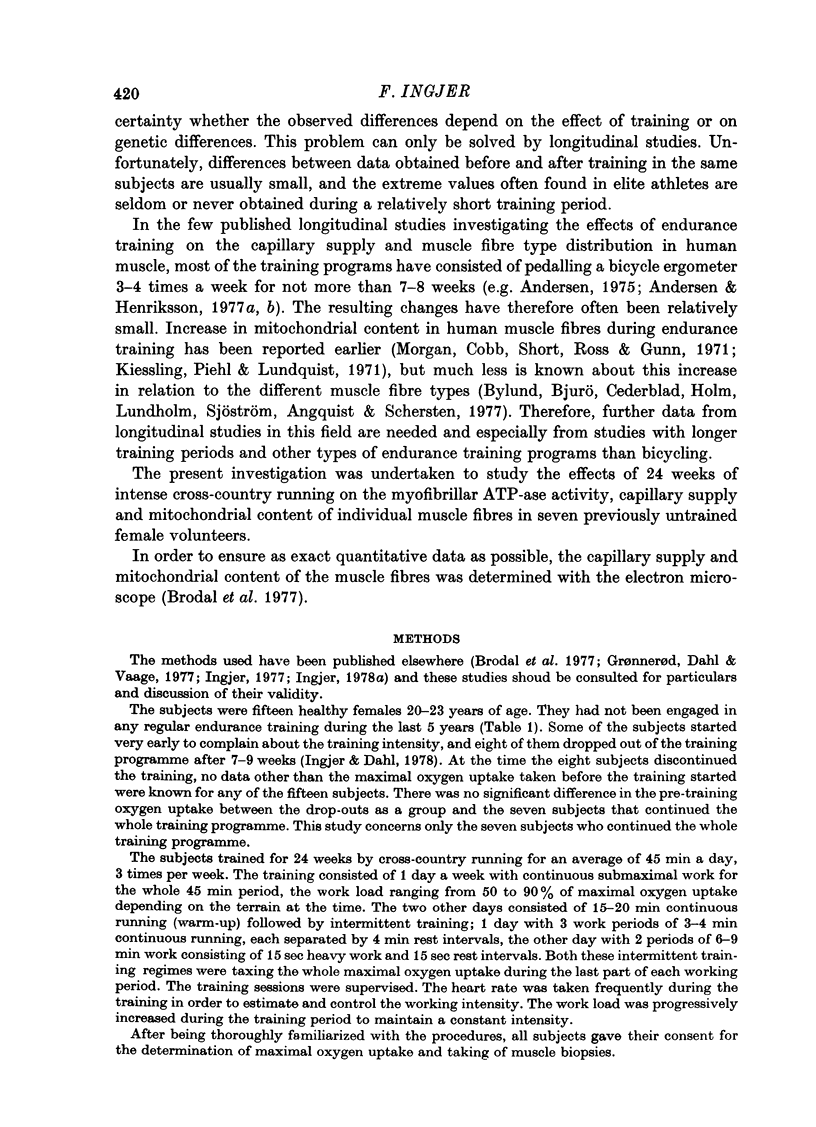
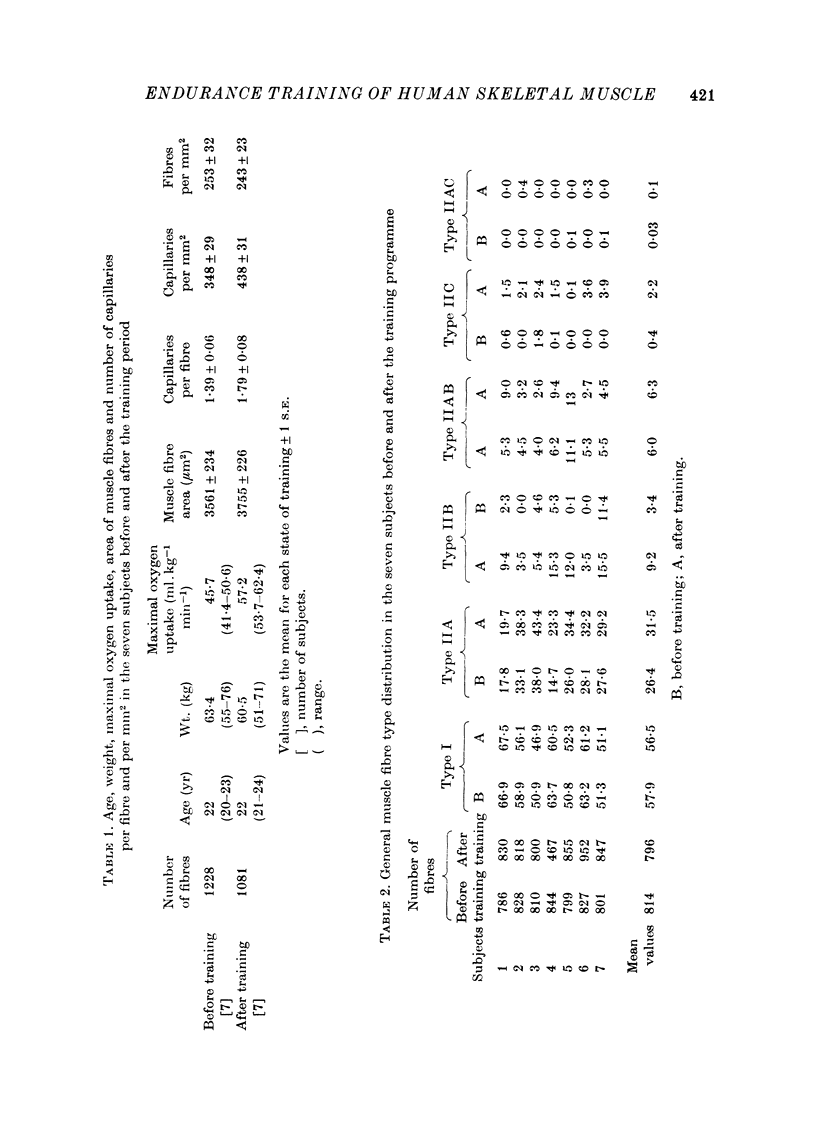
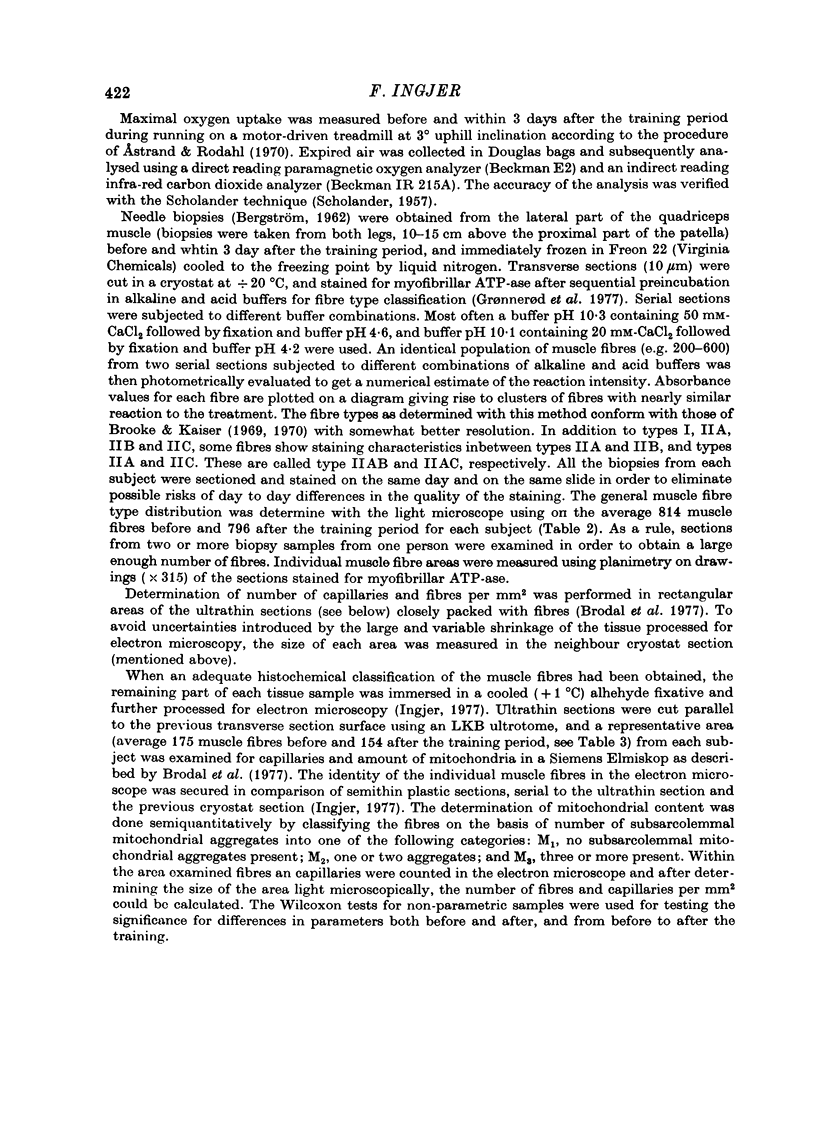
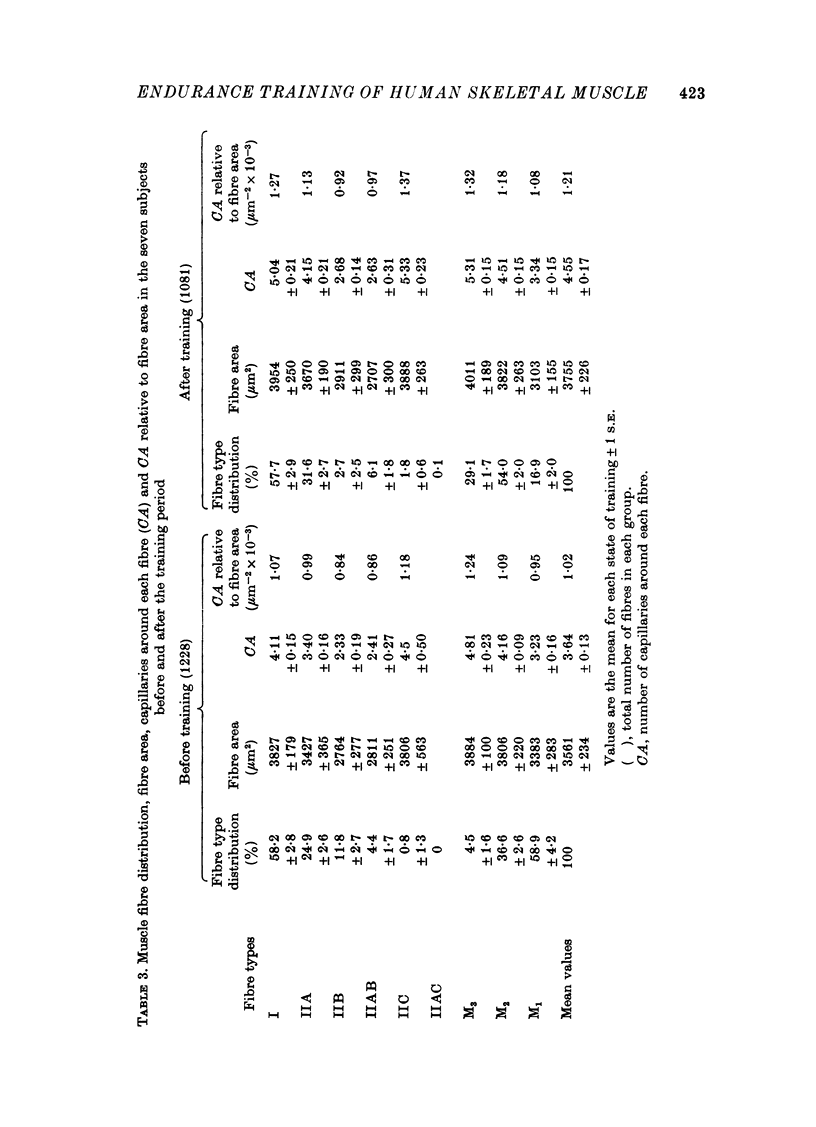
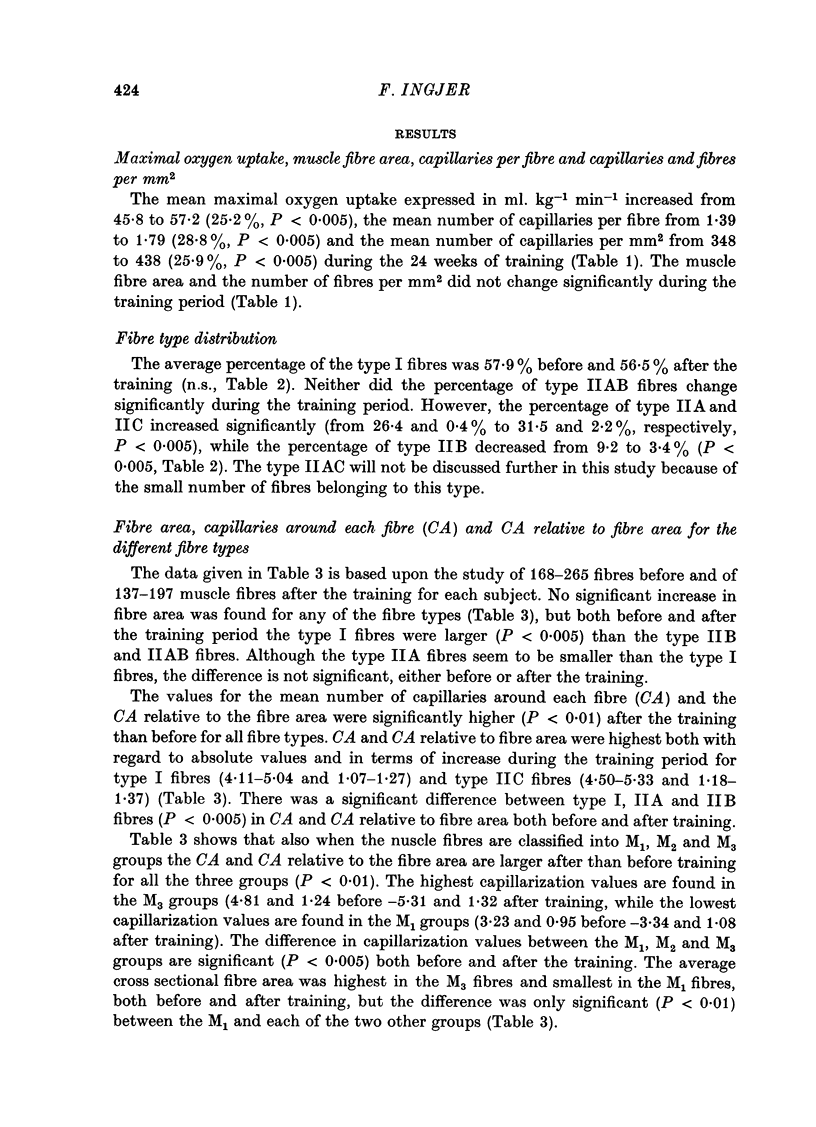
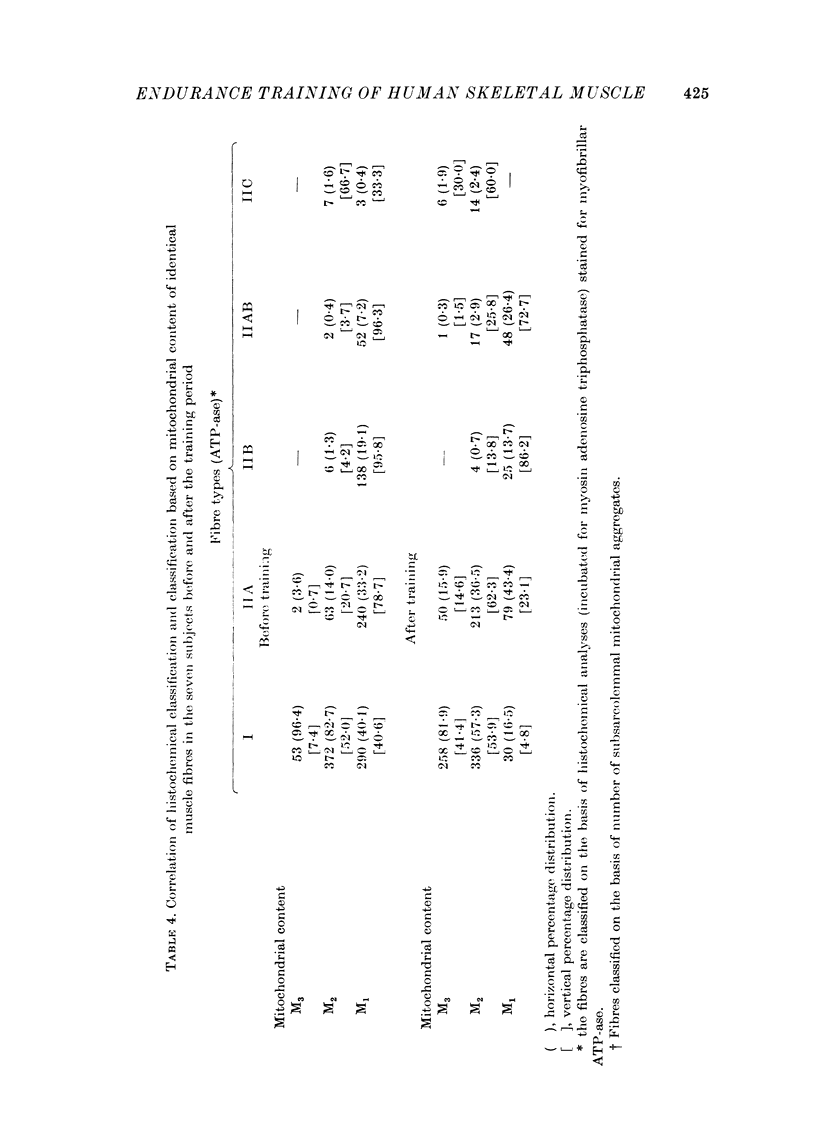
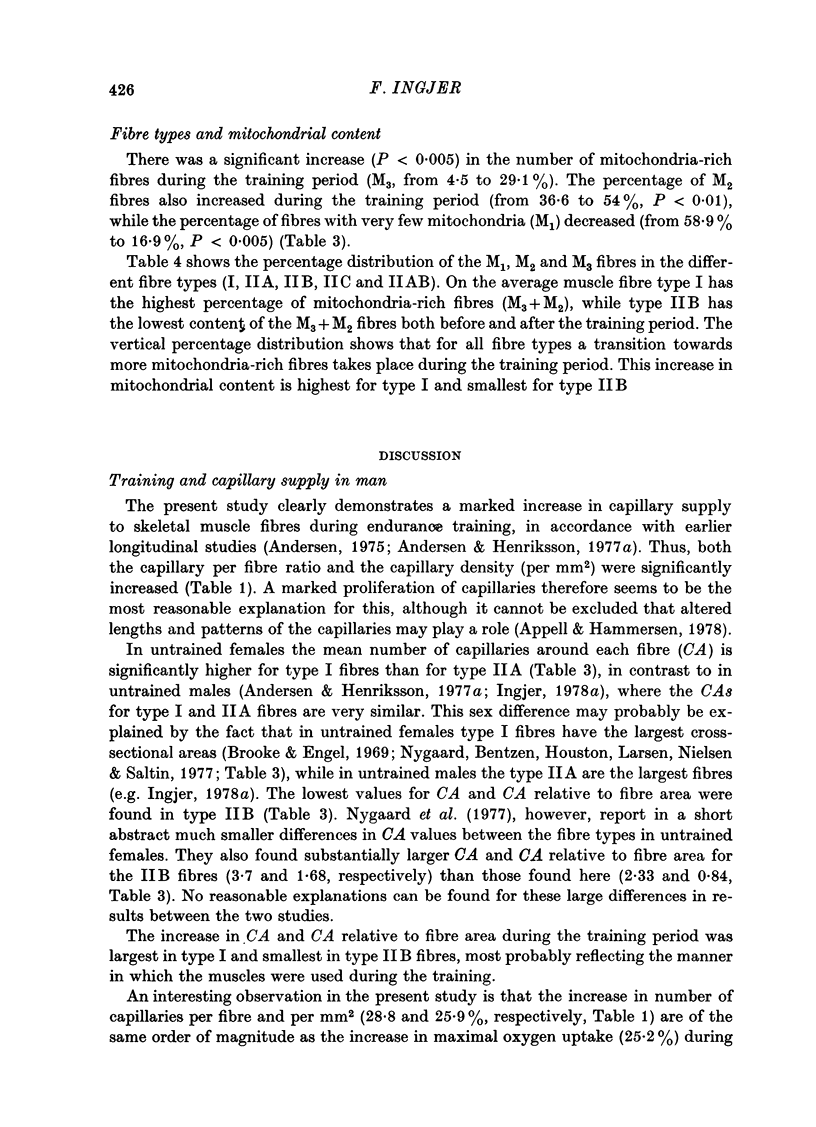
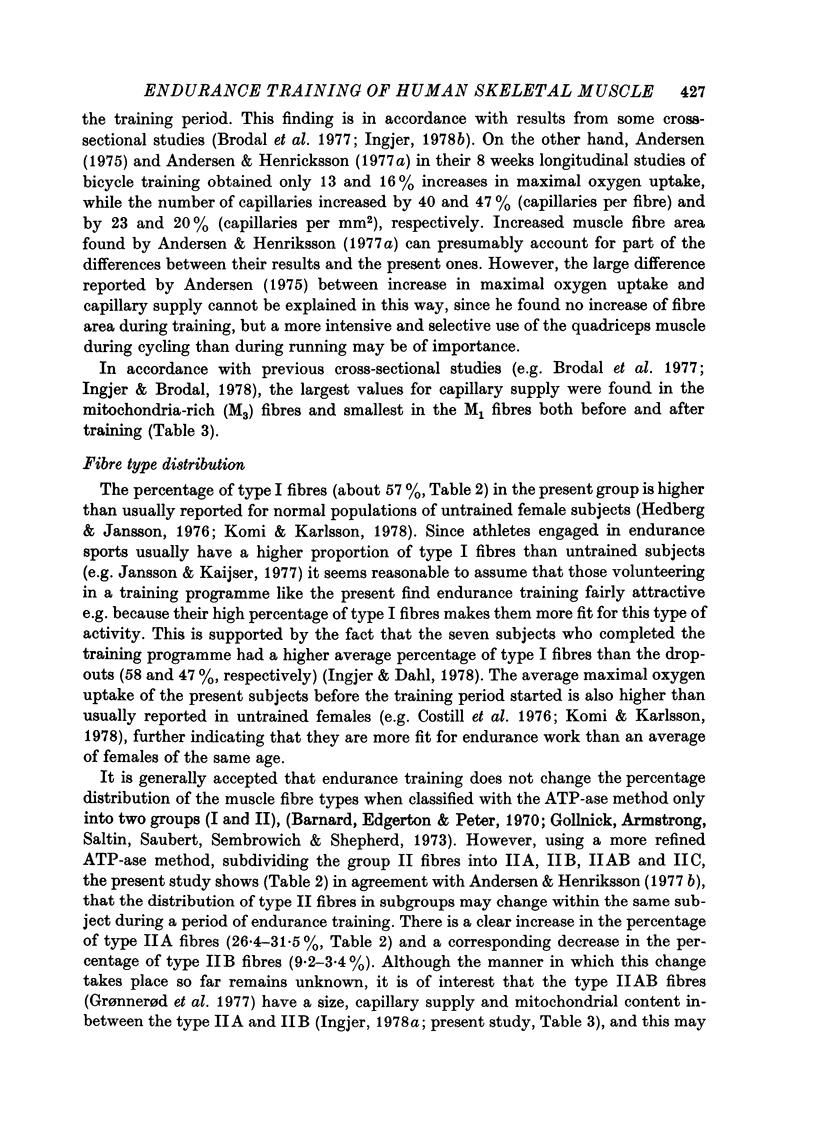
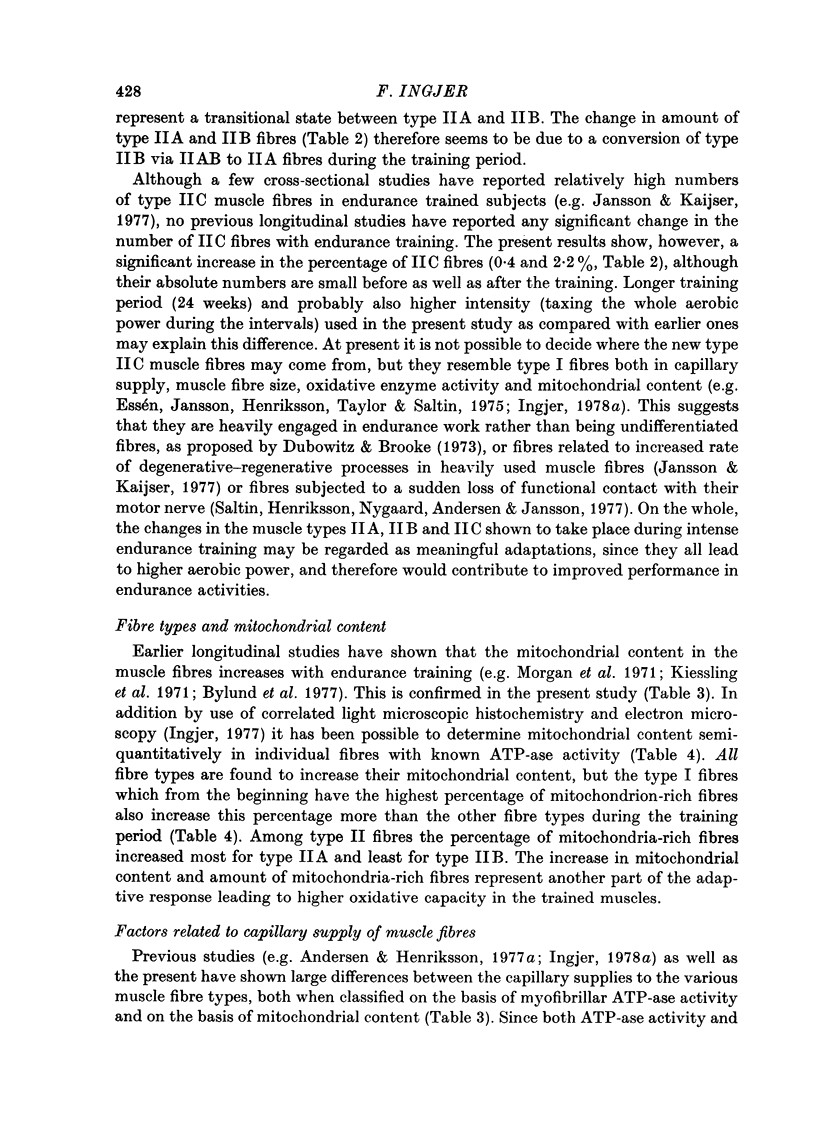
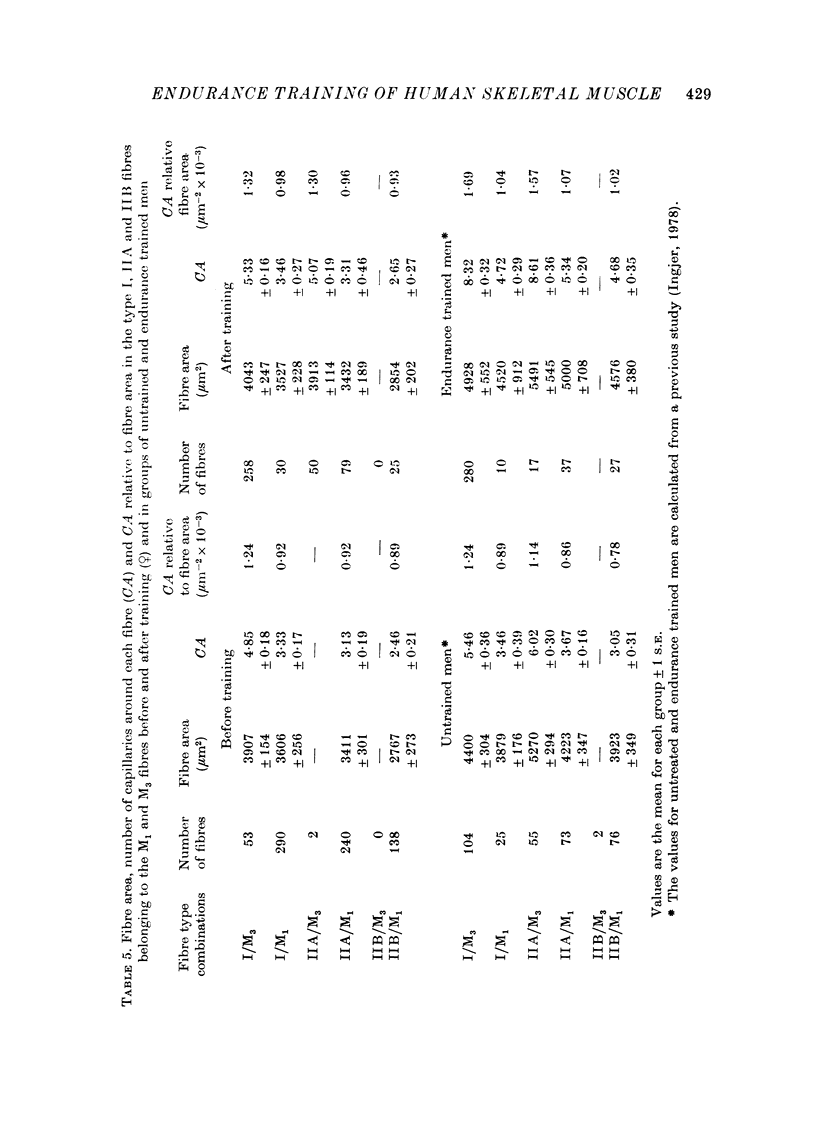
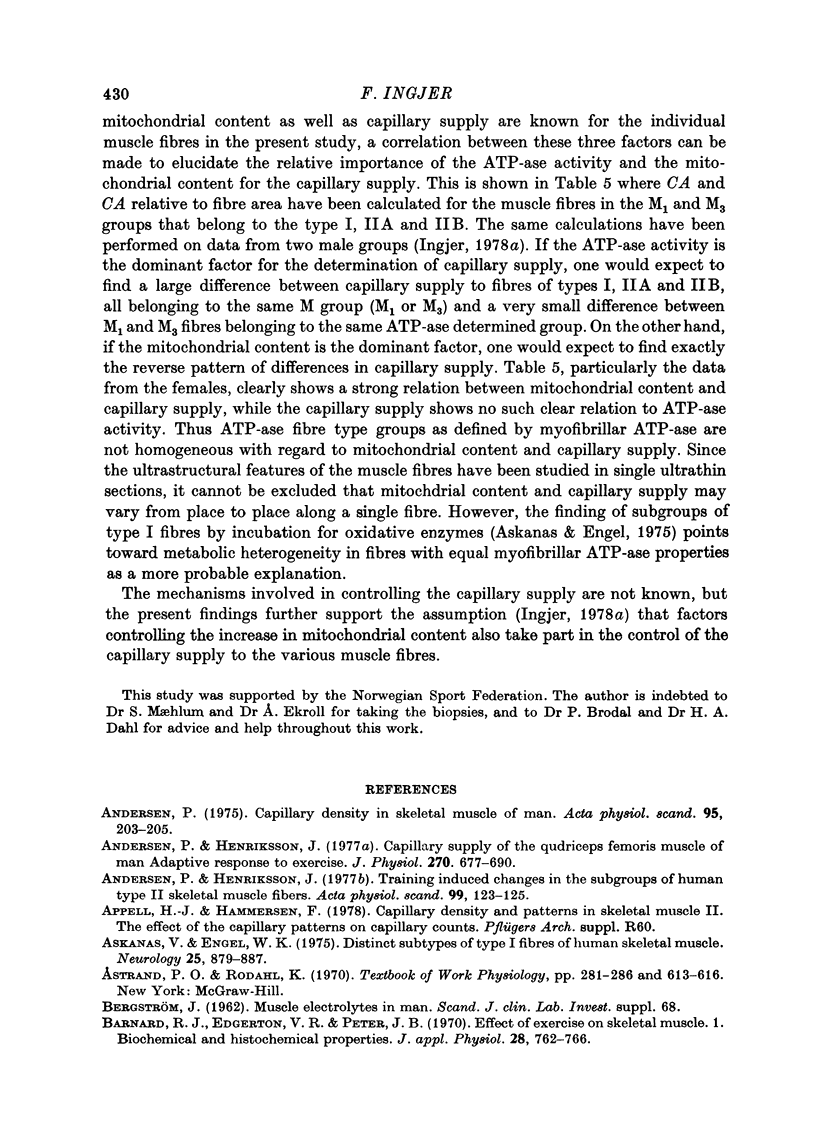
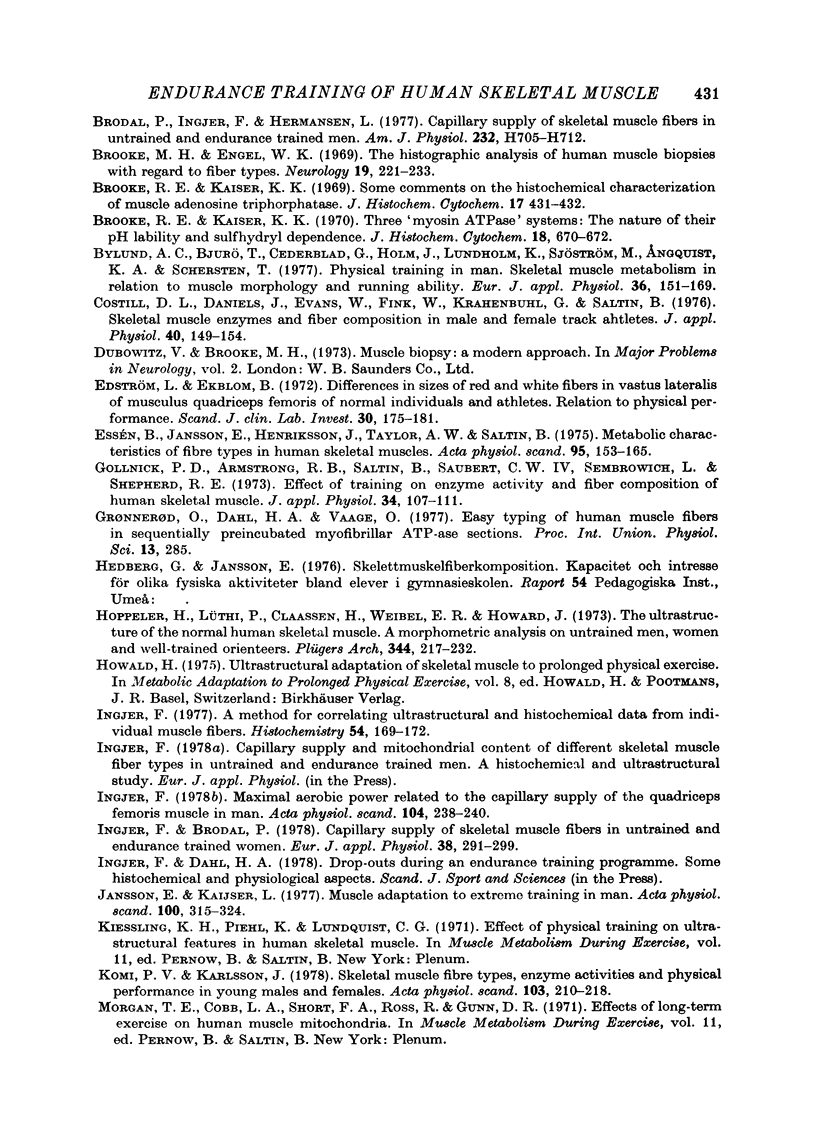
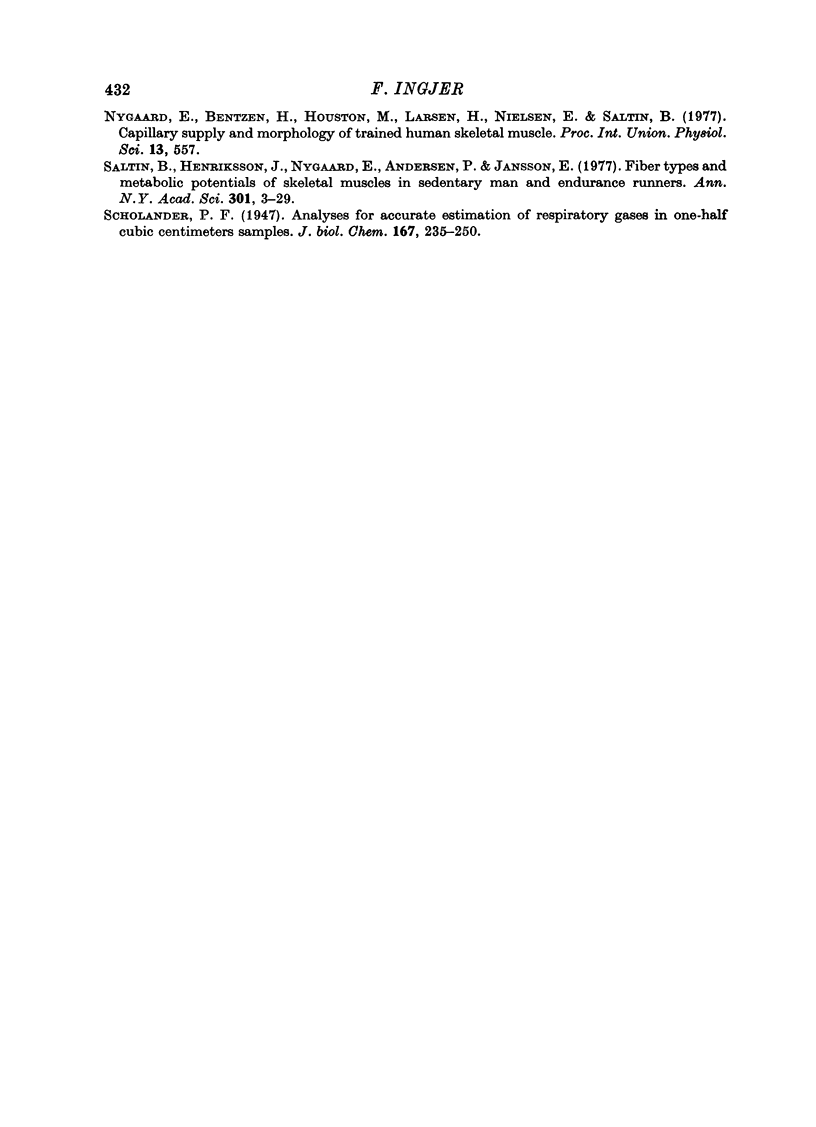
Selected References
These references are in PubMed. This may not be the complete list of references from this article.
- Andersen P. Capillary density in skeletal muscle of man. Acta Physiol Scand. 1975 Oct;95(2):203–205. doi: 10.1111/j.1748-1716.1975.tb10043.x. [DOI] [PubMed] [Google Scholar]
- Andersen P., Henriksson J. Capillary supply of the quadriceps femoris muscle of man: adaptive response to exercise. J Physiol. 1977 Sep;270(3):677–690. doi: 10.1113/jphysiol.1977.sp011975. [DOI] [PMC free article] [PubMed] [Google Scholar]
- Andersen P., Henriksson J. Training induced changes in the subgroups of human type II skeletal muscle fibres. Acta Physiol Scand. 1977 Jan;99(1):123–125. doi: 10.1111/j.1748-1716.1977.tb10361.x. [DOI] [PubMed] [Google Scholar]
- Askanas V., Engel W. K. Distinct subtypes of type I fibers of human skeletal muscle. Neurology. 1975 Sep;25(9):879–887. doi: 10.1212/wnl.25.9.879. [DOI] [PubMed] [Google Scholar]
- Brodal P., Ingjer F., Hermansen L. Capillary supply of skeletal muscle fibers in untrained and endurance-trained men. Am J Physiol. 1977 Jun;232(6):H705–H712. doi: 10.1152/ajpheart.1977.232.6.H705. [DOI] [PubMed] [Google Scholar]
- Brooke M. H., Engel W. K. The histographic analysis of human muscle biopsies with regard to fiber types. 1. Adult male and female. Neurology. 1969 Mar;19(3):221–233. doi: 10.1212/wnl.19.3.221. [DOI] [PubMed] [Google Scholar]
- Brooke M. H., Kaiser K. K. Some comments on the histochemical characterization of muscle adenosine triphosphatase. J Histochem Cytochem. 1969 Jun;17(6):431–432. doi: 10.1177/17.6.431. [DOI] [PubMed] [Google Scholar]
- Brooke M. H., Kaiser K. K. Three "myosin adenosine triphosphatase" systems: the nature of their pH lability and sulfhydryl dependence. J Histochem Cytochem. 1970 Sep;18(9):670–672. doi: 10.1177/18.9.670. [DOI] [PubMed] [Google Scholar]
- Bylund A. C., Bjurö T., Cederblad G., Holm J., Lundholm K., Sjöstroöm M., Angquist K. A., Scherstén T. Physical training in man. Skeletal muscle metabolism in relation to muscle morphology and running ability. Eur J Appl Physiol Occup Physiol. 1977 Mar 15;36(3):151–169. doi: 10.1007/BF00421747. [DOI] [PubMed] [Google Scholar]
- Costill D. L., Daniels J., Evans W., Fink W., Krahenbuhl G., Saltin B. Skeletal muscle enzymes and fiber composition in male and female track athletes. J Appl Physiol. 1976 Feb;40(2):149–154. doi: 10.1152/jappl.1976.40.2.149. [DOI] [PubMed] [Google Scholar]
- Edström L., Ekblom B. Differences in sizes of red and white muscle fibres in vastus lateralis of musculus quadriceps femoris of normal individuals and athletes. Relation to physical performance. Scand J Clin Lab Invest. 1972 Oct;30(2):175–181. doi: 10.3109/00365517209081108. [DOI] [PubMed] [Google Scholar]
- Essén B., Jansson E., Henriksson J., Taylor A. W., Saltin B. Metabolic characteristics of fibre types in human skeletal muscle. Acta Physiol Scand. 1975 Oct;95(2):153–165. doi: 10.1111/j.1748-1716.1975.tb10038.x. [DOI] [PubMed] [Google Scholar]
- Gollnick P. D., Armstrong R. B., Saltin B., Saubert C. W., 4th, Sembrowich W. L., Shepherd R. E. Effect of training on enzyme activity and fiber composition of human skeletal muscle. J Appl Physiol. 1973 Jan;34(1):107–111. doi: 10.1152/jappl.1973.34.1.107. [DOI] [PubMed] [Google Scholar]
- Hoppeler H., Lüthi P., Claassen H., Weibel E. R., Howald H. The ultrastructure of the normal human skeletal muscle. A morphometric analysis on untrained men, women and well-trained orienteers. Pflugers Arch. 1973 Nov 28;344(3):217–232. doi: 10.1007/BF00588462. [DOI] [PubMed] [Google Scholar]
- Ingjer F. A method for correlating ultrastructural and histochemical data from individual muscle fibers. Histochemistry. 1977 Oct 22;54(2):169–172. doi: 10.1007/BF00489675. [DOI] [PubMed] [Google Scholar]
- Ingjer F., Brodal P. Capillary supply of skeletal muscle fibers in untrained and endurance-trained women. Eur J Appl Physiol Occup Physiol. 1978 May 30;38(4):291–299. doi: 10.1007/BF00423112. [DOI] [PubMed] [Google Scholar]
- Ingjer F. Maximal aerobic power related to the capillary supply of the quadriceps femoris muscle in man. Acta Physiol Scand. 1978 Oct;104(2):238–240. doi: 10.1111/j.1748-1716.1978.tb06273.x. [DOI] [PubMed] [Google Scholar]
- Jansson E., Kaijser L. Muscle adaptation to extreme endurance training in man. Acta Physiol Scand. 1977 Jul;100(3):315–324. doi: 10.1111/j.1748-1716.1977.tb05956.x. [DOI] [PubMed] [Google Scholar]
- Komi P. V., Karlsson J. Skeletal muscle fibre types, enzyme activities and physical performance in young males and females. Acta Physiol Scand. 1978 Jun;103(2):210–218. doi: 10.1111/j.1748-1716.1978.tb06208.x. [DOI] [PubMed] [Google Scholar]
- Saltin B., Henriksson J., Nygaard E., Andersen P., Jansson E. Fiber types and metabolic potentials of skeletal muscles in sedentary man and endurance runners. Ann N Y Acad Sci. 1977;301:3–29. doi: 10.1111/j.1749-6632.1977.tb38182.x. [DOI] [PubMed] [Google Scholar]


